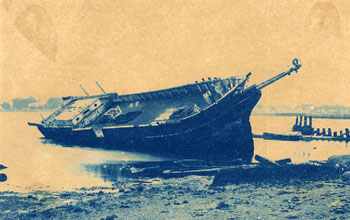Stone Fleet
The whaling industry also suffered closer to home. Demand for whale products fell sharply in the North and Southern markets were cut off completely. Not long after the War began, the Atlantic was sunk by a Confederate privateer. This prompted many whale merchants to insure their ships at sea for huge sums of money. Many ships that were too expensive to insure were kept in port and most whaleships that returned from voyages were not sent back out. During the Civil War, the size of the American whaling fleet shrank by a half.
Given the extra expense and danger of whaling during wartime, ship owners willingly participated in a Union plan to prevent supplies from entering Confederate ports. In 1861, the secretary of the Union navy, Gideon Welles, decided to try something new in an attempt to block supplies from entering and leaving Southern ports. He arranged to sink large vessels in the shipping channels of key harbors.
Old whaling vessels were readily available and perfectly suited to carry heavy loads of stone that would speed their carefully plotted sinking. Whale merchants who sold their vessels at bargain prices preferred to earn something and contribute to the war effort rather than watch a good portion of their fleet sit idly in port. In all, forty-five whaleships were purchased, most of them from New Bedford, Massachusetts and New London, Connecticut.

New Bedford Whaling Museum